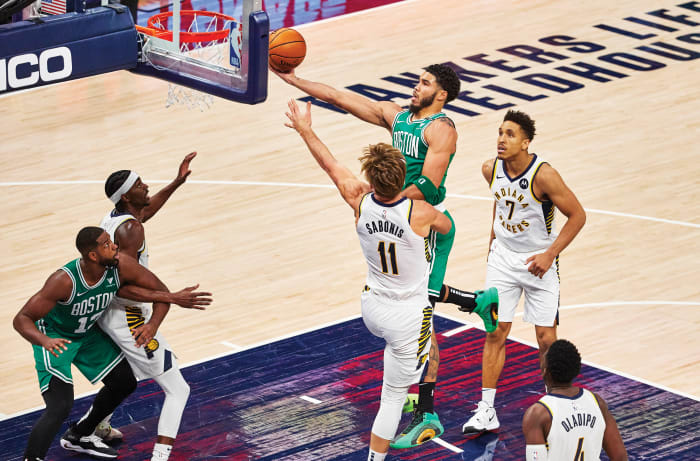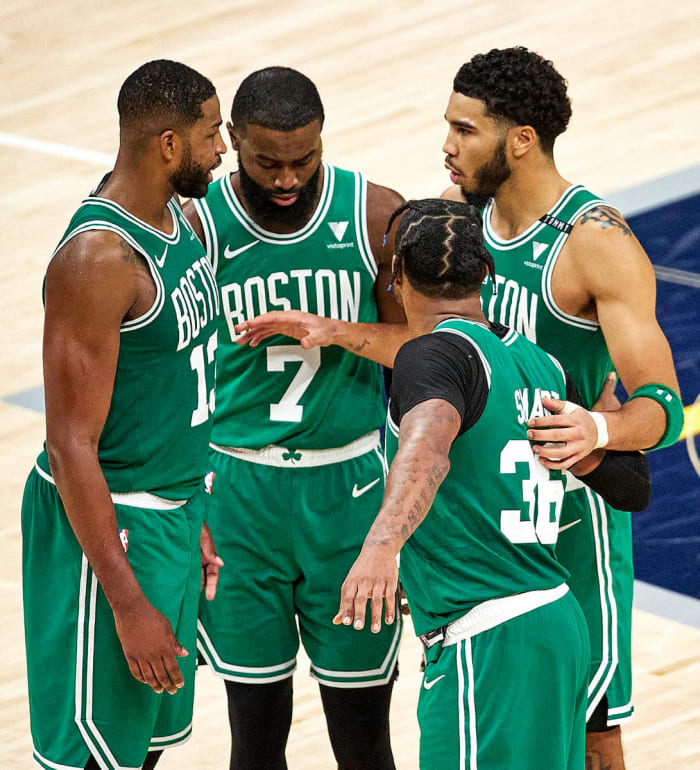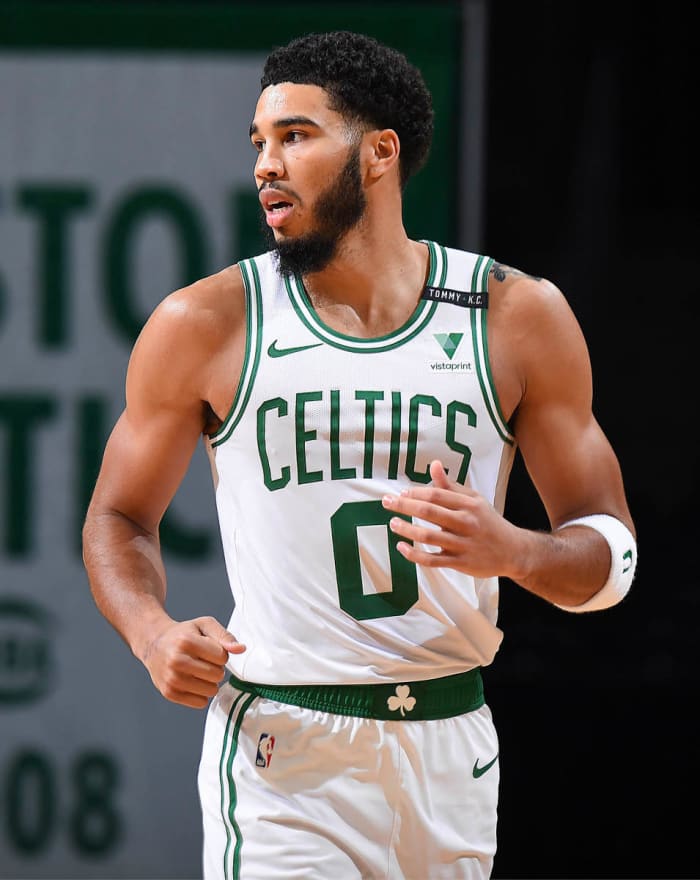Family Guy
It's God, then Mom—or at least that’s the running order of most acceptance speeches. After the man upstairs, Kevin Durant thanked his mother when receiving his MVP award in 2014, a powerful moment that, naturally, later evolved into an internet meme. Ditto Giannis Antetokounmpo, who had tears in his eyes when he paid tribute to his mom at the NBA awards show in 2019, while Mrs. Antetokounmpo, seated in the gallery, brushed away a few of her own. Jayson Tatum isn’t an MVP (yet) but if (when) that day comes, God’s likely to get second billing.
Who knows where Brandy Cole would be if 22 years ago her world didn’t change forever? Class president, a hotly recruited volleyball player at University City High in suburban St. Louis, Cole toyed with the idea of applying to MIT, with an eye toward becoming a biomedical engineer. A relationship with Justin Tatum, a Saint Louis University basketball player, led to an unexpected pregnancy the summer after she graduated. A positive test confirmed it. Then another. Then another. For weeks, Cole was in denial. She didn’t tell her mother, Kristie, who had been a teenage mother herself. Early in the pregnancy, while working at a Walgreens, Cole collapsed. “I was anemic,” she says, “and didn’t know it.” She was taken to the hospital, where a nurse, phone in hand, came into the room and said she had a call from Brandy Cole’s mom. When she asked for Brandy, Cole told the nurse she had never heard of her.
Soon, though, reality would set in. And so would Cole’s focus. She wouldn’t put her life on hold. While raising Jayson, Cole earned a bachelor’s degree from Missouri–St. Louis, then a master’s and a law degree—but he would come first. Her son would go to private schools, even if it meant frequent visits to predatory payday lenders to make ends meet. It meant humbling experiences. When food was scarce, Cole would send Jayson to a neighbor’s to pick up leftovers. “Chicken pot pie was the go-to,” says Tatum. He would eat the filling. Cole would make do with the crust.
It meant supporting her son’s dream. Cole sold cellphones, worked in an office at UPS, underwrote workman’s comp policies for Travelers, did grant writing for nonprofits—anything to make ends meet. In between she kept up a full class schedule. Often, Jayson would tag along, fiddling with a Game Boy or sleeping next to her in a lecture hall. “He should have college credit hours,” says Cole.
That dream was basketball. In second grade, his teacher asked the class what they wanted to be when they got older. There were doctors, lawyers, veterinarians. Jayson said he wanted to play in the NBA. The teacher told him to choose something more realistic. His mother believed it was. When Jayson was 13, she called Drew Hanlen, a skills trainer who worked with prominent NBA players. “I want you to train Jayson,” Cole said. “I’ll take out a loan to pay you if I have to.”
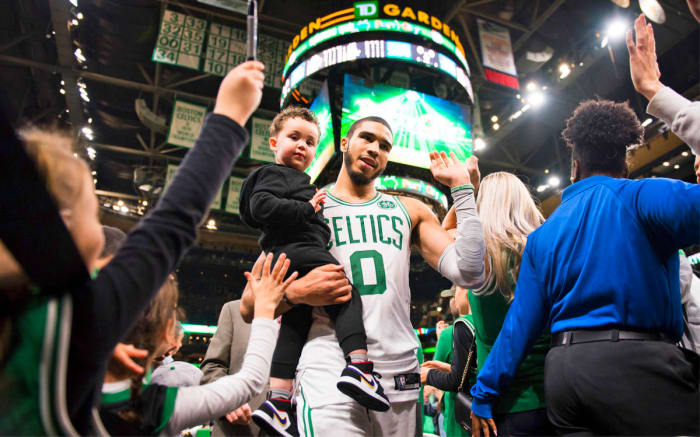
LITTLE DEUCE COUP Tatum’s three-year-old son has succeeded in becoming something of a celebrity in his own right. Jayson Jr. (in November 2019) was one of the breakout stars of the bubble; after he arrived, Stevens tweeted, “I walked down the hallway with Deuce today, which is the highlight of my 70 days here.”
Kathryn Riley/Getty Images
Initially, Hanlen declined. Cole rang Besta Beal, her former high school volleyball coach—and mother of Bradley Beal, a Hanlen client and a Florida-bound star. Soon after, Hanlen got a call from Bradley. “J is like a little brother to me,” Beal said. “Can you help him out?”
Hanlen relented—but remained skeptical. “A lot of kids want to be great,” says Hanlen. “But most aren’t willing to do the work.” The first workout was grueling. Cardio drills, five minutes each, nonstop. “I basically tried to kill him,” jokes Hanlen.
Afterward, Jayson called his mom. “He said he thought he was going to pass out,” says Cole. “But [also] that you were going to have to carry him off that court.” The next day, Hanlen brought in Scott Suggs, then a sharpshooting guard at Washington. Hanlen pointed to different spots on the floor—the wings, the top of the key, two mid-post spots, seven in all—and directed Suggs and Jayson to go one-on-one. Jayson lost all seven times. “He just got worked,” Hanlen said. “But he kept coming back.”
And working. Through Chaminade Prep, where Tatum emerged as National Player of the Year in 2016. At Duke, where he overcame an early foot injury to earn All-ACC honors in his lone season. And in the NBA. At 22, Tatum got his first All-NBA nod last season, his third, and picked up right where he left off in this one. Before he was placed in the league’s COVID-19 protocol, the 6' 8", 210-pound forward was averaging career highs in scoring (26.9) and rebounding (7.1) through the first 10 games. “His ceiling is really high,” says Hanlen. “And he’s just getting started.”
The education of Jayson Tatum began in an unsurprising place: on YouTube. Justin Tatum’s basketball career ended in 2005. He had always supported Jayson financially as best he could, and when he returned from overseas, he took on a prominent role in coaching Jayson. His early instructions: Watch how the pros score. Not when they score. How they do it. “He didn’t want me looking at the end result,” says Jayson. “He wanted me looking at their footwork and how they got open, how they came off the pin-down, how they came off the screen. To look at all the things before the shot.”
Justin was tough. “Early on,” says Cole, “I thought Justin was insane.” (The two never married but have maintained a cordial relationship.) Jayson recalls a middle school game he was struggling in. At halftime, Justin burst into the locker room. “He grabbed me by my jersey and literally picked me up and put me against the wall,” says Jayson. “And I just remember, everybody was just watching it like, Damn, is this really happening? And I had tears coming down my eyes the whole second half.” The result? “I had like 25 straight after that.”
When Justin began coaching high school ball he would bring Jayson to practice, sticking him in drills with kids six or seven years older. “It was a struggle for him,” Justin said in an interview with NBC Sports Boston last February. “Jayson probably cried a couple of times, but he always came back. He always wanted the challenge.”
Justin’s coaching proved revealing. “Jayson plays better mad,” says Cole. Normally, though, angering Tatum is difficult. He routinely shrugs off criticism, and Cole will often check his arm, asking whether he has a pulse. “He’s very logical,” says Cole. “When there is adversity, he doesn’t think crying about it will fix anything.” At Duke, following a close loss to N.C. State, Cole was incensed by criticisms she read on social media. Tatum’s response: Mom, you don’t know any of those people—why are you reading it?
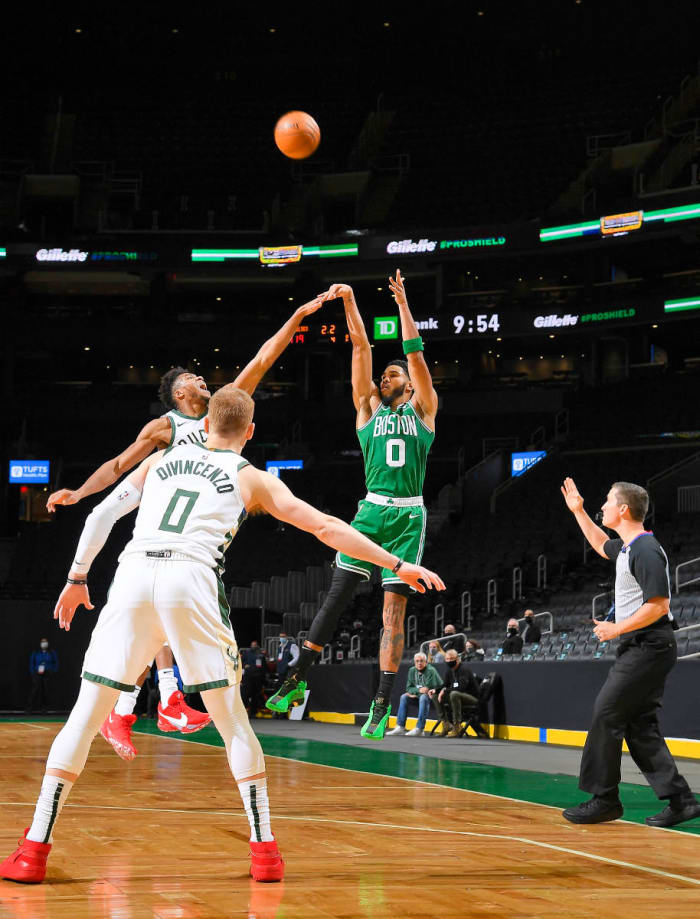
TRIPLE THREAT Tatum—who is averaging more than twice as many three-point attempts as he did two years ago when he relied on midrange Js—nailed a three to beat the Bucks in the season opener.
BRIAN BABINEAU/NBAE/GETTY IMAGES
“Nothing becomes personal to him,” says Duke coach Mike Krzyzewski. “He has great humility. I like to say that in any environment, his boat still has oars.” But when Tatum does get angry—look out. After Tatum scored seven points in the first half against Virginia, Krzyzewski jumped on Tatum in the locker room, calling him a “soft-ass St. Louis kid.” Tatum erupted for 21 in the second half.
Talent can breed arrogance. Tatum, though, has always been coachable. Hanlen saw it early. Video of Kobe Bryant, Michael Jordan and Tracy McGrady helped Tatum absorb the nuances of a jab step. In high school, Tatum would occasionally shoot from only certain areas. “He’d basically be using other teams for practice,” says Hanlen. At Duke, Tatum struggled early with his shot. Following the loss to N.C. State, Hanlen flew to Durham. At the time, Tatum’s three-point percentage was 29.5%. The next day, the two drove to a nearby high school. Over two hours, Hanlen altered Tatum’s arm angle by 30 degrees. “Basically lowered his shot pocket,” says Hanlen. Tatum shot 41.2% from three the rest of the way.
Absorbing coaching is one thing. But Tatum also implements it quickly. “Share something with Jayson once,” says Celtics coach Brad Stevens, “and he usually does it the next time down the floor. Stevens recalls a sequence during an exhibition game in Charlotte in Tatum’s rookie season. The Hornets ran a play the Celtics hadn’t worked on defending. Tatum got lost the first time. When Charlotte ran the same play a few possessions later, Tatum broke it up. Last season Celtics assistant Jay Larranaga showed Tatum a clip of Kemba Walker getting to the rim with an in-and-out dribble. The next night Tatum scored on a similar move. “His brain never gets sped up,” says Larranaga. “You tell him something in a game and he is able to immediately apply it.”
As Tatum blossoms into one of the game’s elite all-around players, it’s easy to forget that drafting him was considered a risky proposition for Boston. In 2017, the Celtics, thanks to a fruitful trade with Brooklyn four years earlier, owned the first pick. Washington’s Markelle Fultz was widely projected as the top player. A few weeks before the draft, Boston’s brass flew to Los Angeles to watch Tatum work out. Krzyzewski was already in the Celtics’ ear, insisting Tatum was “by far” the best offensive player in the draft. In an empty gym at St. Bernard’s High, Tatum shot 275 threes. He made 83% of them. “He shot 34% from three in college,” says Stevens. “But that wasn’t real. That ball hit the net like it was supposed to.”
The Celtics were sold. Boston flipped spots with Philadelphia, which had the third pick. The Sixers took Fultz (Boston officials insist that Fultz’s subsequent shooting woes were not apparent in his workout.) As expected, Lonzo Ball went next to the Lakers, leaving Tatum sitting at No. 3.
Confirmation that it was a wise move came quickly. “His skill level for such a young kid was so impressive,” says former Celtics assistant Micah Shrewsberry, who left in 2019 to become an assistant at Purdue. “He was fluid in everything he did for a guy his size.” Tatum averaged 17.7 points in Summer League. At his first practice, he grabbed every rebound and deflected a handful of passes. “None of us knew how good a defender he was,” says Stevens. At an open workout in the fall, Tatum knocked off Gordon Hayward in a shooting contest. “There’s a swagger to him,” says Shrewsberry. “He didn’t want to be an NBA player. He wanted to be a great NBA player.”
It's a chilly evening in Detroit in early January when Stevens boards a bus to the airport after a win over the Pistons. Tatum scored 24 points, the last two on a game-winning jumper in the closing seconds. Stevens praises the shot, but quickly shifts the discussion to two games earlier, against Memphis, when Tatum, on a play run for Jaylen Brown, made a hard cut that sprung Brown for a shot. “A play like that,” says Stevens, “is just as good.”
Tatum’s rise hasn’t been without rocky moments. After a breakout rookie season, Tatum entered his second year with high expectations. So, too, did Boston, which had pushed LeBron James’s Cavaliers to seven games in the conference finals without Kyrie Irving and Hayward, and would welcome the two stars back. But chemistry issues plagued the 2018–19 Celtics, and the team fizzled out in the second round of the playoffs. Tatum, who had been a focal point of the offense during Boston’s ’18 playoff run, struggled to adapt to a new role, and his shooting percentages dipped. His shot selection, particularly an affinity for midrange jumpers, drew criticism. Faced with failure for the first time, Tatum blamed himself. “He took a lot on,” says Shrewsberry. “He has such high expectations for where he wants to be.” Adds Hanlen, “He was overthinking. He took [Boston’s struggles] really personal. He wasn’t living up to his own expectations.”
Tatum’s takeaway from that snakebit season? “Don’t take anything for granted,” says Tatum. “The year before when we went to the Eastern Conference finals, I thought that s--- was normal. That this was just how it was supposed to be. And then the next year I realized things can go south. And it made me really appreciate the year before and just how valuable things like that are.”

MAMA'S BOY Tatum owes much of his success to Brandy, who saw to it that her son went to the best schools and got the best training—all while she worked toward three degrees.
Courtesy of Brandy Cole
A roster shake-up before last season saw Irving exit and Tatum return to a leading role. Presented with opportunity, Tatum seized it, averaging 23.4 points. His three-point percentage jumped back above 40%. His playmaking, something Tatum has worked diligently on, improved. Last summer, in the NBA bubble, Boston faced Oklahoma City in an early scrimmage. During one sequence, a Thunder defender drifted away to defend the pass on a Tatum drive. Chris Paul, loud enough for many in the quiet arena to hear, barked that Tatum wasn’t going to pass. Enter Playmaker Tatum. In the Celtics’ second seeding game, Tatum handed out a career-high eight assists in a win over Portland; a few games later, he dished out six against Orlando. This season coaches say his passing out of double teams has improved.
Leadership, at least the vocal kind, doesn’t come naturally to Tatum, but there have been strides there, too. After his rookie season, Tatum worked out with Bryant. Growing up, Tatum idolized Bryant. He studied his game religiously. (Celtics coaches privately grumbled that when ESPN released an episode of Details, a Bryant-helmed show that took a deep dive into players, during the 2018 conference finals against the Cavs, Tatum attempted to implement Bryant’s suggestions mid-series). But the thing that really stuck with Tatum was a conversation. Bryant recalled how San Antonio had created a special trap to flummox him in the mid-post. To beat it, Bryant would reposition the Lakers’ big men so they would be open when the Spurs deployed the defense. The lesson: Good players can beat their man. The best beat the other team.
That’s the kind of leadership Boston is looking for. “We’re asking him to share what he sees,” says Stevens. The rest is by example. As much as Tatum has accomplished, there is more to unlock. After the 2018–19 season, Tatum worked on adding a side-step three; he shot 43.0% on those last season, an NBA best. Analytics suggest his best shots come off isolations, slot drives and post-ups. But Tatum is growing more comfortable with downhill pick-and-roll threes, while Boston envisions him eventually thriving in catch-and-shoot situations. Hanlen says that a focus during the brief offseason was getting to the free throw line more. “He’ll lead the NBA in scoring someday,” says Hanlen. “You will be able to run a championship offense through him.”
Basketball, though, is no longer Tatum’s singular focus. His son, Jayson Jr.—Deuce, as he is known—was born during Tatum’s rookie season. Cole recalls the early-morning phone call in 2017 when an 18-year-old Tatum told her that he was going to be a father. “I think he expected me to go crazy,” says Cole. But Cole flashed back to her own experience, how the support of her family helped her through it. “The last thing he needed was for me to go off,” says Cole. “I told him it would all work out.”
And it has. Deuce is a fixture at Celtics games. (Tatum and Deuce’s mother, Toriah Lachell, maintain a healthy coparenting relationship.) A video of the two celebrating Tatum’s first All-Star selection went viral last January, as did footage of the two reuniting in the NBA bubble after Brandy brought him to Florida. When Tatum agreed to a five-year, $195 million extension in November, Deuce was there to watch him sign the contract. He’s become an inspiration. “[Jayson] says all the time, when Deuce gets older, he wants him to say, ‘My Dad is cold,’ ” says Hanlen.
He’s his motivation, just like Jayson was to Brandy. Around the house, Brandy likes to grumble that Jayson cost her a college experience. Tatum’s favorite punch line: “I think it all worked out.”
It did. Thanks, Mom.
